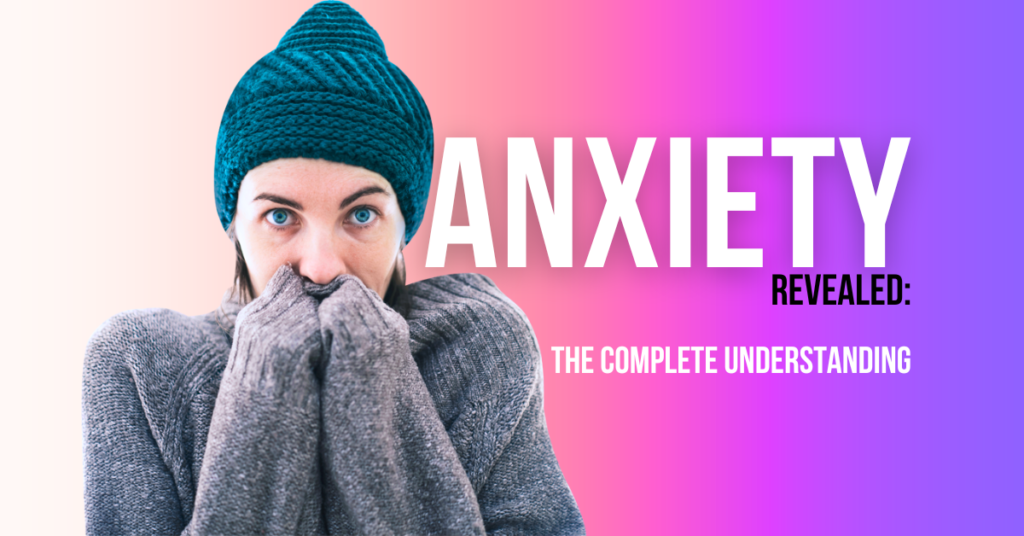
Anxiety and anxiety disorders are terms often used interchangeably, but they represent distinct concepts in the realm of mental health.
Understanding the differences between Anxiety and anxiety disorders, these two terms is crucial for accurate diagnosis, effective treatment, and promoting mental well-being.
Anxiety is a natural and adaptive response to stress or perceived threats. It is a common emotion experienced by everyone at various points in life. Feeling anxious before a job interview, an exam, or a significant life event is entirely normal. In these situations, anxiety can even enhance performance by heightening alertness and focus. It becomes problematic when it exceeds the typical stress response, becoming chronic, overwhelming, and disproportionate to the situation at hand.
Anxiety disorders, on the other hand, are a group of mental health conditions characterized by excessive, prolonged, and debilitating anxiety. Unlike the occasional anxiety everyone experiences, anxiety disorders persist over time and interfere significantly with daily functioning, relationships, and overall quality of life. These disorders include Generalized Anxiety Disorder (GAD), Social Anxiety Disorder, Panic Disorder, and specific phobias. Anxiety disorders often involve intense and irrational fears that trigger avoidance behaviors, leading to significant distress and impairment.
Common Signs and Symptoms of Anxiety Disorders:
Anxiety disorders don’t wear a single face; they manifest in various forms, each unique in its challenges. Generalized Anxiety Disorder (GAD) brings forth persistent worry about everyday events, accompanied by physical symptoms like restlessness and fatigue. Panic Disorder unleashes sudden, intense panic attacks, often mistaken for heart attacks due to their severity. Social Anxiety Disorder inflicts paralyzing fear in social situations, hindering social interactions. Specific Phobias trigger irrational fears, leading to avoidance behaviours. Obsessive-Compulsive Disorder (OCD) traps minds in distressing thoughts and repetitive rituals. Separation Anxiety Disorder imprisons young hearts in fear of separations, and Selective Mutism stifles communication in certain contexts.
- Generalized Anxiety Disorder (GAD):
Generalized Anxiety Disorder involves excessive, uncontrollable worry or anxiety about various life situations or activities. Individuals with GAD often anticipate disaster and are overly concerned about everyday matters such as health, work, family, or finances. The worry is difficult to control and may interfere significantly with daily functioning. Physical symptoms such as restlessness, fatigue, muscle tension, and sleep disturbances often accompany the persistent worry.
- Panic Disorder:
Panic Disorder is characterized by recurrent and unexpected panic attacks. These are sudden episodes of intense fear, often accompanied by physical symptoms like heart palpitations, sweating, trembling, shortness of breath, and a feeling of impending doom. Individuals with panic disorder often worry about future panic attacks and may change their behaviour to avoid situations that could trigger an attack.
- Social Anxiety Disorder (Social Phobia):
Social Anxiety Disorder, also known as Social Phobia, involves an intense fear of social or performance situations where scrutiny or evaluation by others is possible. Individuals with social anxiety fear being embarrassed, humiliated, or negatively judged by others. They tend to avoid social situations or endure them with significant distress. Physical symptoms such as blushing, sweating, and trembling may occur in social situations.
- Specific Phobia:
Specific Phobia is characterized by a marked and persistent fear of a specific object or situation. Common phobias include fear of flying, heights, animals, or blood. Individuals with specific phobias actively avoid the feared object or situation, or they endure it with intense fear. The fear or anxiety is disproportionate to the actual danger posed by the specific object or situation.
- Selective Mutism:
Selective Mutism is an anxiety disorder primarily observed in children, where they consistently do not speak in specific social situations (like school or social gatherings) despite speaking in other settings (like at home). The inability to speak interferes with educational or occupational achievement and hinders social communication. It often arises due to extreme social anxiety and fear of negative evaluation.
- Separation Anxiety Disorder:
Separation Anxiety Disorder involves excessive fear or anxiety concerning separation from home or attachment figures, leading to significant distress. Children or adolescents with this disorder may be reluctant to leave home, go to school, or stay away from their caregivers. They often experience nightmares about separation or physical symptoms (such as headaches or stomach-aches) when separation is anticipated.
List of treatment approaches for various anxiety disorders
- Cognitive-Behavioural Therapy (CBT): Focuses on identifying and challenging negative thought patterns and behaviours.
- Exposure Therapy: Involves gradually facing feared situations or stimuli to reduce avoidance behaviours and anxiety responses.
- Medication: Antidepressants, anti-anxiety medications, or other psychotropic drugs can help regulate brain chemicals associated with anxiety.
- Mindfulness-Based Stress Reduction (MBSR): Utilizes mindfulness meditation and yoga to alleviate anxiety symptoms and promote relaxation.
- Breathing Exercises: Teaches controlled breathing techniques to manage symptoms during anxiety or panic attacks.
- Relaxation Techniques: Includes practices like deep breathing, progressive muscle relaxation, and visualization to induce calmness.
- Cognitive Restructuring: Involves challenging and reframing irrational or negative thought patterns.
- Group Therapy: Provides a supportive environment where individuals can share experiences and learn coping strategies together.
- Family Therapy: Involves family members in the therapeutic process to provide support and improve communication within the family unit.
- Speech Therapy: Focuses on improving communication skills, especially for conditions affecting verbal expression.
- Gradual Exposure Exercises: Systematic desensitization to feared objects or situations, reducing avoidance behaviours over time.
- Exposure and Response Prevention (ERP): Involves confronting feared thoughts or situations without engaging in compulsive behaviours, reducing anxiety triggers.
- Lifestyle Changes: Includes regular exercise, balanced diet, adequate sleep, and stress management techniques to promote overall well-being.
- Biofeedback: Teaches individuals how to control physiological functions (such as heart rate and muscle tension) to reduce anxiety.
- Art or Music Therapy: Utilizes creative expression as a therapeutic outlet, aiding in emotional processing and relaxation.
Diagnosing Anxiety Disorders:
Diagnosing anxiety disorders is a meticulous journey that combines clinical expertise, psychological assessments, and empathetic understanding. Mental health professionals follow a structured process to accurately identify and understand the nature of anxiety disorders in individuals. Here’s an overview of the diagnostic process:
- Clinical Interview:
A crucial first step involves a detailed clinical interview. Mental health professionals engage in open and non-judgmental conversations with the individual, encouraging them to share their feelings, thoughts, and behavioural patterns. This interview provides valuable insights into the individual’s emotional state, triggers, and the impact of anxiety on their daily life.
- Psychological Assessments:
Psychological assessments play a vital role in the diagnosis. Various standardized tests and questionnaires specifically designed to assess anxiety symptoms are administered. These assessments help quantify the severity of symptoms, providing a quantitative perspective to complement the qualitative information gathered during the clinical interview.
- Case History Taking:
A comprehensive case history is compiled, encompassing the individual’s personal and family background, medical history, and any significant life events or traumas. Understanding the individual’s life context helps in identifying potential triggers or predisposing factors contributing to anxiety disorders.
- Differential Diagnosis:
To ensure accuracy, mental health professionals conduct a differential diagnosis. This process involves ruling out other medical or psychological conditions that might present similar symptoms. By carefully considering various possibilities, clinicians can confirm the presence of an anxiety disorder and differentiate it from other disorders.
- Behavioural Observations:
Observing the individual’s behaviour in different situations is integral. Clinicians note specific anxiety-related behaviours, including avoidance, restlessness, excessive reassurance-seeking, or compulsive actions. These observations provide valuable context and aid in diagnosis.
- Collaboration with Other Healthcare Providers:
In some cases, collaboration with other healthcare providers, such as primary care physicians or neurologists, might be necessary. Physical health conditions or medications can sometimes contribute to anxiety symptoms. Consulting with other professionals ensures a comprehensive assessment.
Parental and Social Support for Individuals with Anxiety:
- Parents and loved ones can create a safe environment where individuals feel comfortable discussing their feelings and fears. Encouraging open dialogue fosters trust and can alleviate some of the emotional burden.
- Parents and friends can educate themselves about anxiety disorders. Understanding the condition helps in providing empathetic support and reduces stigma.
- Providing a listening ear and emotional support can make a significant difference. Being non-judgmental and understanding can help individuals feel valued and accepted.
- Encouraging individuals to seek help from mental health professionals is crucial. Supporting them in scheduling appointments and attending therapy sessions can be immensely helpful.
- Individuals with anxiety might find it challenging to manage daily tasks. Providing practical assistance, such as helping with chores or accompanying them to social events, can reduce stress.
- Encouraging relaxation techniques such as deep breathing, meditation, or yoga can aid in managing anxiety symptoms. Participating in these activities together can make it more enjoyable and supportive.
- Identifying triggers for anxiety and avoiding them collectively can create a supportive environment. This might involve making certain lifestyle changes or avoiding specific situations that induce anxiety.
Can Anxiety Disorders Be Outgrown?
Anxiety disorders are treatable conditions, and with appropriate interventions, many individuals experience significant improvements in their symptoms. In some cases, especially in children and adolescents, anxiety disorders may lessen or resolve with age, therapy, and coping skill development.
Common Misconceptions about Anxiety Disorders:
- “Anxiety disorder is Just Normal Worrying”: While occasional worry is a part of life, anxiety disorders involve excessive, persistent, and often irrational fear or dread, significantly impacting daily functioning.
- “Anxiety Disorders Are Just a Sign of Weakness”: Anxiety disorders are legitimate medical conditions, not a reflection of character. They result from a complex interplay of biological, genetic, environmental, and psychological factors.
- “People with Anxiety Disorders Should Just Relax”: Anxiety disorders are not simply a matter of relaxation. They involve intricate neurological and psychological processes that require specialized treatment and support.
- “Anxiety Disorders Are Not Serious”: Anxiety disorders can severely impair a person’s quality of life, affecting relationships, work, and overall well-being. Without proper treatment, they can lead to significant distress and functional impairment.
- “Anxiety Disorders Are Easy to Snap Out Of”: Overcoming anxiety disorders often requires professional help, including therapy and, in some cases, medication. It’s not a matter of willpower or determination alone.
- “Children Can’t Have Anxiety Disorders”: Children can and do suffer from anxiety disorders. Early intervention is crucial, as anxiety disorders in childhood can impact development and academic performance.
Coexisting Disorders or Conditions with Anxiety Disorders:
- Depression: Anxiety disorders often coexist with depression, leading to a challenging condition known as comorbid anxiety and depression.
- Obsessive-Compulsive Disorder (OCD): OCD frequently accompanies various anxiety disorders, complicating the symptoms and treatment approaches.
- Post-Traumatic Stress Disorder (PTSD): Individuals with a history of trauma may develop PTSD alongside an anxiety disorder, amplifying their emotional distress.
- Attention-Deficit/Hyperactivity Disorder (ADHD): ADHD and anxiety disorders frequently coexist, making it crucial to address both conditions for effective treatment.
- Eating Disorders: Conditions like anorexia nervosa, bulimia nervosa, or binge-eating disorder can occur alongside anxiety disorders, exacerbating emotional and physical challenges.
- Substance Use Disorders: Individuals struggling with substance abuse often experience anxiety disorders, leading to a complex dual diagnosis that requires integrated treatment.
- Chronic Medical Conditions: Chronic illnesses like diabetes, cardiovascular diseases, or autoimmune disorders can exacerbate anxiety symptoms, creating a challenging interplay between physical and mental health.
Anxiety disorders are intricate and multifaceted conditions, where the boundaries between normal worry and clinical concern can blur. Understanding the nuances of these disorders, dispelling common misconceptions, and acknowledging their potential coexistence with other conditions are essential steps toward building a compassionate and informed society. With this understanding, we can extend empathy, support, and effective treatments to those navigating the labyrinth of anxiety, offering them a path towards brighter days, peace, and emotional well-being.
Written By –
Ms. Sabeera Nowreen
Psychologist




